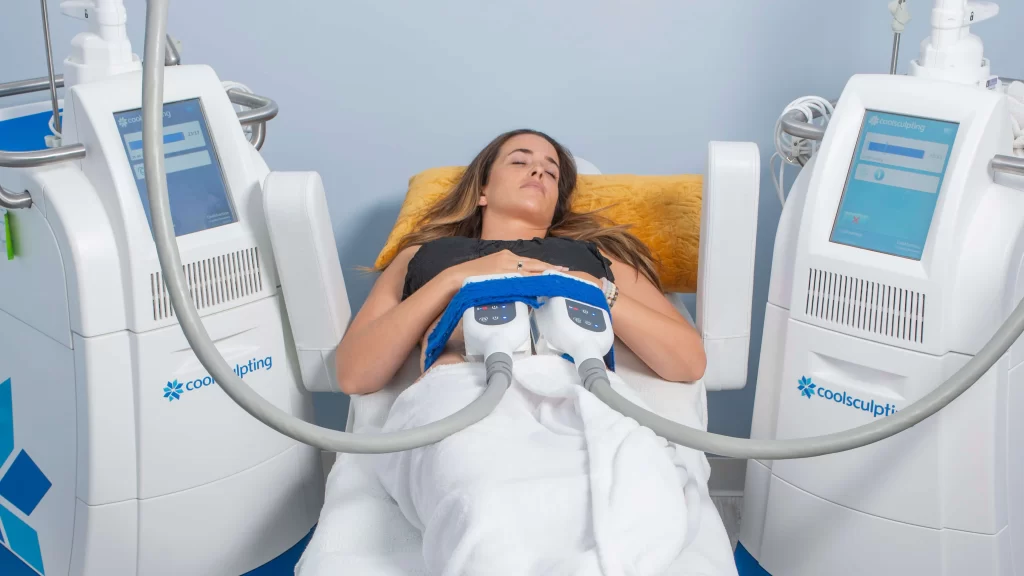Did you know that around 30 percent of adults are unhappy with their body fat, undergoing liposuction or performing liposuction for coolsculpting results? Many men are studying options like cryolipolysis and surgical removal to tackle stubborn fat in this area, hoping for a positive result. Cryolipolysis, also known as fat freezing, offers a non-invasive way to reduce fat in the area without surgery, resulting in use for both men and women. On the other hand, surgical removal as a fat reduction option involves more significant procedures with longer recovery times for men seeking fat loss results and targeting subcutaneous fat. Both methods have their pros and cons. Understanding these differences in the area of subcutaneous fat can help you make an informed choice about fat removal candidates and their potential fat removal results. This post dives into cryolipolysis vs surgical removal, highlighting effectiveness, safety, recovery, and fat freezing for men. Get ready to discover which option, including fat freezing for men, might be right for you!
Understanding Cryolipolysis
What is Cryolipolysis
Cryolipolysis is a method that involves freezing fat cells in men to eliminate them. The process targets specific areas of the body for fat reduction in men. This technique is a noninvasive alternative to surgical fat removal for men. It allows men to achieve a slimmer appearance through fat freezing without undergoing surgery.
This method works by applying controlled cooling, also known as fat freezing, to the skin’s surface. As the temperature drops, fat cells crystallize and die off. Over time, the body naturally processes and eliminates these dead fat cells. This results in a noticeable reduction in fat layer thickness.
Cryolipolysis Procedure
The cryolipolysis procedure uses a specialized device designed to cool fat cells. The device brings the temperature down to levels that destroy the targeted fat cells without harming surrounding tissue. Typically, this procedure takes place in a clinical setting.
No anesthesia is required during the treatment. Patients can relax as the device works on their body. Each session lasts about one hour per treated area. Many people find it comfortable enough to read or use their phones during the process.
The treatment plan may involve multiple sessions for optimal results. Doctors often recommend spacing out sessions by several weeks. This allows the body time to eliminate the destroyed fat cells effectively.
Cryolipolysis has gained popularity due to its advantages over traditional methods like liposuction. It offers minimal downtime, meaning patients can return to their daily activities quickly. There are fewer risks involved since it is noninvasive.
Results typically become visible after a few weeks. Full effects may take up to three months to appear as the body continues to flush out fat cells. Many individuals report satisfaction with their new contours following treatment.
In summary, cryolipolysis presents an effective option for those seeking body contouring without surgery. By focusing on specific areas, it helps reduce stubborn fat deposits that diet and exercise may not fully address.
Understanding Surgical Removal
What is Liposuction
Surgery is a common method for fat removal. Liposuction is one of the most popular types of surgical procedures. It removes unwanted fat from specific areas of the body. Surgeons perform this surgery by using suction techniques. They make small incisions in the skin and insert a tube called a cannula. This tube helps to vacuum out excess fat.
Liposuction works best for larger volumes of fat removal. It is not a weight-loss solution but rather a way to contour the body. Patients often seek this procedure when diet and exercise have failed to achieve desired results.
Liposuction Procedure
The liposuction procedure requires anesthesia. Surgeons may use local or general anesthesia, depending on the extent of the surgery. During the operation, the surgeon makes incisions in targeted areas. These areas may include the abdomen, thighs, arms, or other places with excess fat.
Once the incisions are made, the surgeon inserts the cannula through them. The cannula connects to a vacuum device that removes fat from beneath the skin. This process allows surgeons to sculpt and shape the body effectively. Recovery time varies from patient to patient, but many return to normal activities within weeks.
In contrast to cryolipolysis, which uses cold temperatures to freeze fat cells, liposuction provides immediate results. Patients can see changes right after surgery. However, it also comes with risks such as infection or scarring from cutting and stitching.
Surgeons recommend discussing goals and expectations before choosing liposuction. Each patient’s needs are different. Therefore, understanding all options is essential for making an informed decision.
Patients should also consider the costs associated with surgical procedures like liposuction. Insurance typically does not cover cosmetic surgeries unless deemed medically necessary.
Comparing Procedure Durations
Cryolipolysis Duration
Each cryolipolysis session lasts approximately one hour. This makes it a convenient option for many people. Sessions can fit into a lunch break or a busy schedule. Patients often find the process relaxing and easy to manage.
Multiple sessions may be needed for optimal results. Many individuals require at least two to three treatments to see significant changes. This can vary based on body type and desired outcomes. After each session, patients experience no downtime. They can return to daily activities immediately. This feature makes cryolipolysis appealing for those who want effective fat reduction without interruptions in their routine.

Liposuction Duration
Liposuction takes longer than cryolipolysis. The procedure duration typically ranges from 1 to 3 hours. This depends on the area treated and the amount of fat removed. Surgeons perform liposuction under anesthesia, which adds to the overall time spent in the facility.
Liposuction is usually completed in a single session. Most patients do not need follow-up procedures unless they desire additional contouring. However, if extensive areas are treated, some patients may require an overnight stay for recovery. This ensures proper monitoring after anesthesia.
Pain Levels of Each Procedure
Pain in Cryolipolysis
Cryolipolysis offers a gentle experience during the treatment. Patients typically feel minimal discomfort. The procedure involves applying cooling panels to the skin. This results in a cold sensation that many find tolerable. Some may notice mild pinching as the device suctions the skin.
Post-procedure, soreness can occur. This soreness is often similar to muscle soreness after exercise. It usually fades within a few days. Most patients return to normal activities immediately after the session. No need for anesthesia makes this option appealing for many.
Pain in Liposuction
Liposuction presents a different scenario regarding pain levels. Patients often experience moderate to significant pain following surgery. The intensity of the pain varies based on the extent of the procedure and individual tolerance.
Pain management is essential after liposuction. Doctors prescribe medications to help control discomfort. These medications are crucial for recovery. Discomfort can last from several days up to weeks. Some patients report feeling tightness and swelling in treated areas.
Comparing both procedures reveals clear differences in pain experience. Cryolipolysis is less invasive and requires no anesthetizing agents. It allows patients to undergo treatment with minimal discomfort. In contrast, liposuction involves surgical techniques that inherently cause more pain.
Patients should consider these factors when choosing between cryolipolysis and surgical removal methods. Understanding potential pain levels helps set realistic expectations for recovery.
Effectiveness of Treatments
Results of Cryolipolysis
Cryolipolysis shows effective results in fat reduction. Patients notice a decrease in fat after a few weeks. The body gradually eliminates the treated fat cells. Full results appear within 2 to 3 months. This method can eliminate up to 20-25% of fat cells in the targeted areas.
Many individuals appreciate that it is non-invasive. There is minimal downtime after treatment. Most patients return to daily activities immediately. This makes cryolipolysis appealing for those seeking less disruption in their lives.
Results of Liposuction
Liposuction provides immediate fat volume reduction. Patients see a significant change right after the procedure. However, final results become clear once swelling subsides. This typically occurs within 3 months post-surgery.
Liposuction can remove a larger amount of fat compared to cryolipolysis. It can eliminate up to 5 to 8 liters of fat during one session. This option suits individuals looking for drastic changes.
Both treatments have their place in body contouring. Cryolipolysis offers gradual improvement, while liposuction gives instant results. Each method has distinct advantages based on individual goals.
Patients should consider the risks involved with each treatment. Cryolipolysis has fewer risks since it is non-invasive. Side effects may include temporary redness or swelling at the treatment site.
Conversely, liposuction carries higher risks due to its surgical nature. These may include infection, scarring, and anesthesia complications. Understanding these factors helps patients make informed decisions.
Ultimately, effectiveness varies based on personal needs and conditions. Consulting with a qualified medical professional is crucial before choosing a treatment plan.
Cost Comparison
Cost of Cryolipolysis
The average cost of cryolipolysis ranges between $2,000 and $4,000. This treatment targets fat cells by cooling them to a specific temperature. The price often varies based on the number of areas treated. For instance, treating multiple areas may increase the total amount.
Insurance typically does not cover cryolipolysis. Many patients pay out-of-pocket for this procedure. A study from the American Society of Plastic Surgeons indicated that costs can also depend on the provider’s experience and location.
Patients should consider these factors when evaluating costs. Some clinics offer payment plans to help manage expenses. Understanding the financial commitment is crucial before proceeding with treatment.
Cost of Liposuction
The average cost of liposuction was around $3,637 as of 2020. This figure reflects the general expense for a standard procedure. Costs can vary significantly based on the extent of the surgery and geographic location. For example, urban areas may have higher costs compared to rural settings.
Additional costs often arise during liposuction. Anesthesia fees can add hundreds to thousands of dollars to the total amount. Facility fees may also apply, depending on where the procedure takes place. Patients need to clarify these potential charges beforehand.
Liposuction is usually performed in a surgical center or hospital. This setting incurs extra fees that might not be present in non-surgical treatments like cryolipolysis.
Both procedures require careful consideration of their costs. Cryolipolysis offers a non-invasive option but at a price that can add up quickly if multiple areas are treated. Liposuction provides more immediate results but comes with higher risks and additional expenses.
Ideal Candidates for Each
Who Benefits from Cryolipolysis
Cryolipolysis is a non-invasive procedure. It works well for individuals who are close to their ideal weight. This method targets stubborn fat areas that diet and exercise often fail to affect. Common areas include the abdomen, thighs, and flanks.
People should be aware of certain conditions before considering this treatment. Those with cold-induced conditions, such as cryoglobulinemia or cold urticaria, may not be suitable candidates. The procedure uses controlled cooling to eliminate fat cells. Therefore, it is important for individuals to follow medical advice regarding their health conditions.
This method is also appealing because it requires no downtime. Patients can resume daily activities immediately after treatment. Overall, those seeking a gentle approach to body contouring may find cryolipolysis ideal.
Who Benefits from Liposuction
Liposuction suits individuals looking to remove larger volumes of fat. This surgical option is effective in reshaping various body parts. Common target areas include the abdomen, thighs, arms, and back.
Good skin elasticity plays a significant role in recovery after liposuction. Individuals with firmer skin tend to heal better and achieve smoother results. This procedure also allows for more dramatic changes compared to non-invasive methods.
Certain groups should avoid liposuction altogether. Pregnant women should wait until after childbirth to consider this surgery. People with heart problems or other serious health issues may face increased risks during the procedure.
Recovery from liposuction involves more time than cryolipolysis. Patients usually need several weeks to fully heal. They must follow post-operative instructions carefully to ensure successful results.
In summary, both cryolipolysis and liposuction offer unique benefits. Choosing between them depends on individual goals and health factors. Those close to their ideal weight may prefer cryolipolysis for its convenience. Conversely, those needing significant fat removal might opt for liposuction.
Comparing Side Effects
Cryolipolysis Side Effects
Cryolipolysis, often known as “fat freezing,” has some common side effects. Patients may experience temporary bruising and skin sensitivity after the procedure. The treated area can also show redness and swelling. These reactions are normal and usually resolve within a few weeks.
Most people tolerate the procedure well. Discomfort is generally mild. Some patients report a feeling of cold during treatment, but this typically fades quickly. Overall, side effects from cryolipolysis are rare and mild compared to surgical options.
Liposuction Side Effects
Liposuction carries more significant risks than cryolipolysis. Patients face potential complications from anesthesia, including reactions and blood clots. Infection is another risk associated with this surgical method. Fluid accumulation can occur post-surgery, leading to additional procedures for correction.
Long-term complications can include contour irregularities. These irregularities may affect the appearance of the treated areas. Some patients might require further surgeries to achieve desired results. Recovery from liposuction can be lengthy compared to cryolipolysis, which requires less downtime.
Both methods have their pros and cons regarding side effects. Cryolipolysis tends to offer fewer risks and a quicker recovery time. In contrast, liposuction may provide immediate results but comes with higher risks and longer recovery.
Patients should weigh these differences carefully before deciding on a treatment option. Consulting with a medical professional is essential for understanding individual risks based on health history.
Recovery Time Comparison
Recovery After Cryolipolysis
Cryolipolysis offers a quick recovery time. Patients experience no significant downtime after the procedure. Many can return to their daily activities immediately. This makes it a convenient option for those with busy schedules.
e may feel minor soreness or swelling in the treated areas. These symptoms typically resolve quickly, often within a few hours to a few days. Most people do not need any special care after the treatment. They simply wait for the body to naturally eliminate fat cells over time.
Recovery After Liposuction
Liposuction requires more time for recovery. The initial recovery period lasts about 3 to 5 days. During this time, patients may feel discomfort and fatigue. They should avoid strenuous activities until cleared by their doctor.
Full recovery from liposuction can take several weeks. Swelling and bruising are common and can last longer than a week. Compression garments are often recommended to reduce swelling and support healing. These garments help shape the body as it recovers.
Patients must follow post-operative instructions carefully. This includes taking prescribed medications and attending follow-up appointments. Proper care can lead to better results and a smoother recovery process.
Comparing these two methods, cryolipolysis is less invasive and allows for quicker recovery. In contrast, liposuction involves surgery and requires more downtime. Individuals should consider their lifestyle when choosing between these options.
Conclusão
Cryolipolysis and surgical removal both offer unique benefits for body contouring. You’ve learned about their differences in pain levels, recovery times, and costs. Each option has its ideal candidates, so it’s crucial to weigh your choices carefully. Understanding these factors helps you make an informed decision that aligns with your goals.
Now that you’re equipped with this knowledge, consider your priorities. Are you looking for a non-invasive solution or willing to commit to surgery? Whatever path you choose, consult a qualified professional to discuss your options. Take charge of your body transformation journey today!
Frequently Asked Questions
What is Cryolipolysis?
Cryolipolysis is a non-invasive fat reduction procedure that uses controlled cooling to eliminate stubborn fat cells. It’s popular for targeting areas like the abdomen and thighs without surgery.
How does Surgical Removal work?
Surgical removal, or liposuction, involves physically removing fat through suction. It requires anesthesia and is suitable for larger fat deposits, offering immediate results compared to non-invasive methods.
Which procedure takes longer?
Surgical removal generally takes longer due to anesthesia and recovery time. Cryolipolysis sessions last about 35-60 minutes, while surgical procedures can take several hours.
Is Cryolipolysis painful?
Cryolipolysis may cause mild discomfort during treatment but is generally well-tolerated. Patients often describe it as a cold sensation rather than pain.
How effective are these treatments?
Both treatments effectively reduce fat, but results vary. Cryolipolysis typically reduces fat by 20-25%, while surgical removal can achieve more significant fat loss in one session.
What are the costs associated with each procedure?
Cryolipolysis usually costs between $2,000-$4,000 depending on the treatment area. Surgical removal can range from $3,000 to $15,000 based on factors like location and complexity.
Who are ideal candidates for each procedure?
Ideal candidates for cryolipolysis are near their target weight with stubborn fat pockets. Surgical removal suits those with larger fat deposits or specific body contouring goals. Always consult a professional for personalized advice.





